In May 2022, Pioneer DJ announced a series of new products throughout the month. Speculation ran rampant. Will we finally see a DJM-900NXS2 update? Maybe a DDJ-1000 MK2? Every week saw a different announcement as anticipation hit a fever pitch – but the first reveals were nothing more than a white XDJ-XZ colorway and a new set of studio monitors.
But perhaps the best is truly saved for last, as Pioneer DJ announced the final product in its last week of the campaign. It was finally something intriguing: a lower-cost, two-channel scratch mixer to round out the series of Serato-focused offerings that started with the DJM-S11 in 2020.
Pioneer DJ hadn’t delved into entry-level or intermediate Serato mixers in a while, so this was a surprise.
Does the DJM-S5 offer something new and groundbreaking? Let’s find out.
Want to get your own DJM-S5? We’ve got them in the DJTT store.
Look
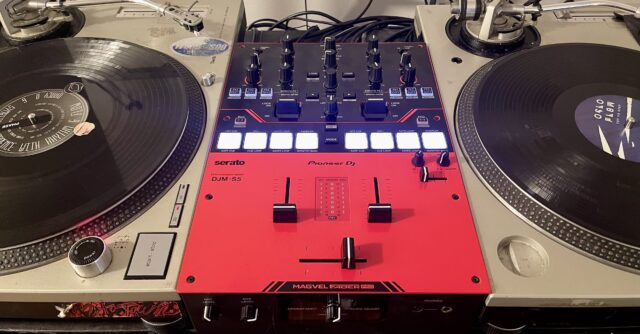
The red colour scheme is the first thing that stands out. Opinions will vary, but I like the change from the standard black to black-on-black seen in DJ gear. With a sleek and economical design, the DJM-S5 looks like the younger sibling of the DJM-S7.
One thing that irks me, though, is the transparent faceplate at the front of the unit. It seems a little redundant – it only reveals the tension mechanism for the Magvel Pro fader.
Layout
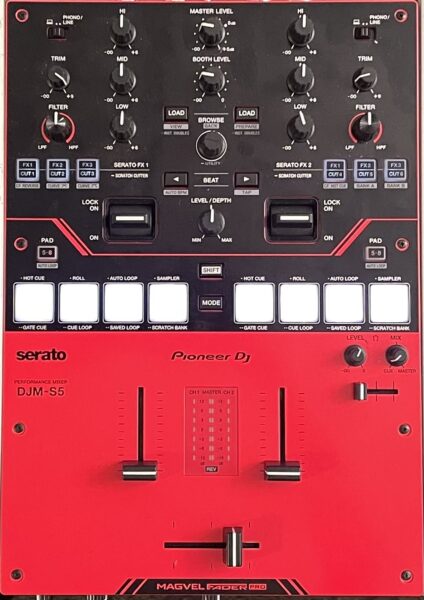
At a glance, the DJM-S5 layout resembles a cross between the DJM-S7 and Numark Scratch. Most notably, the pads are limited to four per side (instead of the usual eight). Also missing are the rows of Pad Mode buttons above, which would allow you to choose what the pads control.
Pioneer DJ removed other standard controls: Parameter buttons for the pads and dedicated Loop controls.
Everything else is standard for a Pioneer DJ mixer in terms of controls and arrangements – from the knob placement to the effects section to the headphone cues.
Pads

These aren’t pads, per se – they’re hard plastic buttons. While they feel functional, I’m a rubber pad guy, and these feel like a downgrade. And as we mentioned earlier, there are only four pads per side instead of the standard eight.
Unlike their other mixers and controllers, there are no parameter buttons on the DJM-S5. Instead, a Pad 5-8 button on either side toggles between Pads 1-4 and 5-8. You can also use the button as an instant Auto-loop button with the Shift button.
The DJM-S5 contains an unprecedented amount of modes for a mixer in this price range. You get eight modes per side, with independent modes on each side.
Pad Modes include Hot Cue, Gate Cue, Loop Roll, Cue Loop, Auto-Loop, Saved Loop, Sampler, and Scratch Bank.
Mode Button
Instead of the traditional separate Pad Mode buttons seen in higher-end mixers and controllers, Pioneer DJ opted to use the pads in conjunction with a single Pad Mode button to switch to different pad functions. To activate these functions, you must hold down the Pad Mode button and press one of the pads – much like the Shift button. Double-clicking on a pad will activate the secondary function.
Faders
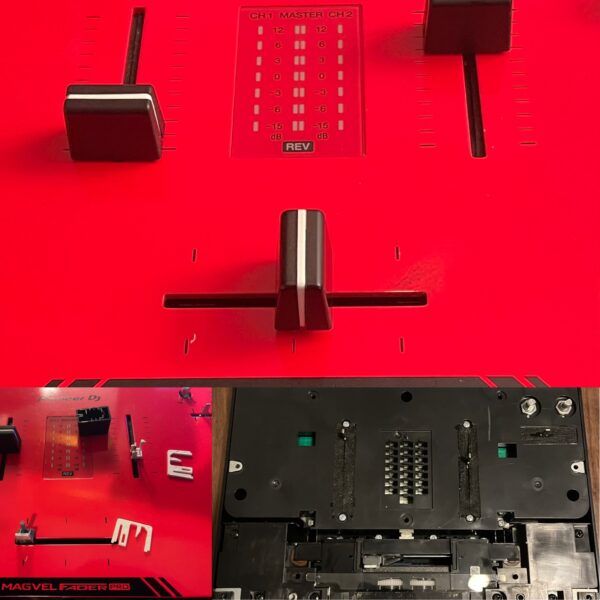
The DJM-S5 contains the heavily lauded Magvel Pro crossfader – a favourite of turntablists worldwide. The fader caps are held in place with Pioneer DJ’s patented P-Lock system. Unfortunately, the upfaders are a lower quality fader, as is typical of Pioneer DJ mixers. I’m not sure if the upfaders are the same as the DJM-S7 faders, but they don’t feel as high quality as on the S11 and S9. In the same vein as the DJM-S7, the upfaders are not easily accessible or replaceable. They are installed under a plate and require extensive teardown to access.
Anecdotally, I’ve heard more than a few people complain about the DJM-S7 line faders failing. I hope Pioneer DJ has improved their components on the DJM-S5.
Effects

While the effects section looks almost identical to the DJM-S7, they are software-based – they come from Serato’s suite of offerings. You get the now-ubiquitous effect paddles that are now showing up in products from multiple companies like Numark, Rane, and Reloop.
The buttons correspond to the six effect slots within Serato, with the single Depth knob affecting all six effects simultaneously. Having the beat timing affect each side independently depending on which effect you have activated is a particularly nice touch.
Shift-pressing these buttons gives you more controls. These include crossfader reverse and curve adjusts, the ability to switch between custom effects banks, and the unique Crossfader Hot Cue feature.
Scratch Cutter
Like the Rane Seventy-Two, the DJM-S5 has a set of “auto-fade” effects. This effect automatically cuts the signal in specific patterns allowing you to create scratch patterns without touching the crossfader. Unlike the Rane Seventy-Two Fader FX though, the Scratch Cutter has the nifty ability to distinguish your forward and backwards platter motions. This allows for more dynamic use of the Scratch Cutter effects.
Crossfader Hot Cue
The Crossfader Hot Cue is another unique feature of the DJM-S5. It allows you to trigger the Hot Cues on a track by opening the crossfader. It’s a little like a CF Start feature on club mixers with a re-trigger feature.
EQs
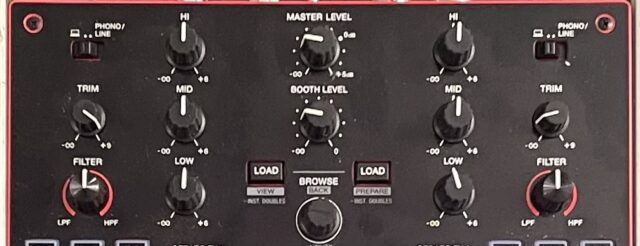
I’ve looked in-depth at the EQ settings on Pioneer DJ gear before, and to my ear, the character of the EQs on the DJM-S5 is comparatively quite similar. While the crossover points and sound are not my favourites, they are perfectly functional.
The pots are metal and have a sturdy feel, and the caps have some textural variations for distinguishing functions simply by touch.
Build Quality
The DJM-S5 has an inner metal chassis with a plastic casing and a metal faceplate. While it feels decent, the plastic is pretty light and there’s a hollowness to the casing. The plastic can also flex somewhat at the seams and joints, so the DJM-S5 doesn’t feel particularly sturdy. That said, it doesn’t feel particularly flimsy either.
Nevertheless, I would say it’s in line with the price point – especially for Pioneer DJ gear that opts to stick with plastic builds.
Sound Quality
The DJM-S5 is a mid-level mixer, so I won’t delve too deeply into its sound quality as much as I would when I review higher-end offerings. I’ve heard better, but I’ve also heard worse. The sound signature is closer to the newer S11 and S7 sound cards than the older S9 or 900NXS – which is a good thing to my ear.
The phono preamps are, again, somewhat middling. I’ve never been the biggest fan of Pioneer DJ gear with vinyl, and this is no different – not my favourite, but not as bad as their controllers and older mixers.
Inputs/Outputs

The DJM-S5 offers a pair of independently-controlled outputs with both XLR and RCA options. I’ve always been a fan of independent outputs, and while having ¼” ports would be great, it’s not a huge loss for this class.
There is a single pair of RCA inputs per side for the decks – each switchable between Line and Phono. An additional RCA input for the AUX and a single mic XLR/1/4″ combo jack round out the inputs on the DJM-S5.
Mic

The Mic is basic – a single volume knob is all you get. No EQs, no tone control, nothing in the Utility software. A knob on the front controls the volume and there is a talkover feature in the hardware utilities.
Power
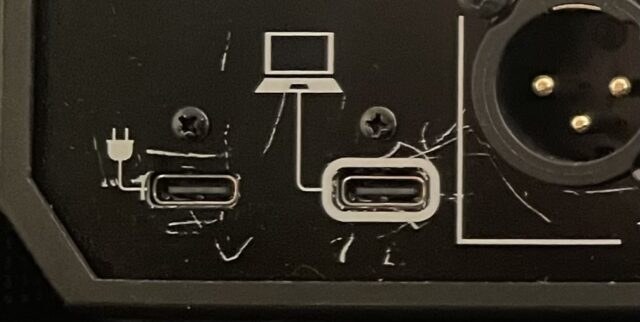
I believe this is the first DJ mixer to offer USB-C power instead of a standard IEC port or external power brick. The practical upshot is that you can use just about any USB port as a power source: a phone charger, laptop, or battery bank. These options make the DJM-S5 a portable beast that doesn’t rely just on a computer for power.
The volume output suffers a bit due to the lower power achieved from phone chargers, but it’s still louder than some bus-powered controllers I’ve used.
Native DVS support with DJay Pro AI
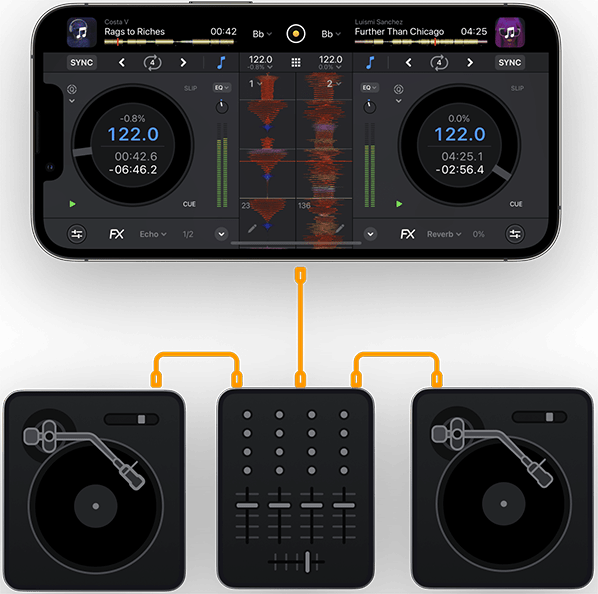
A few weeks into my time assessing the DJM-S5, Algoriddim’s DJay Pro AI announced native DVS support for the DJM-S5. This gives you full, plug-and-play mapping and full DVS support for DJay Pro on both laptops and iOS mobile devices. Unfortunately, there isn’t any Android support for the DJM-S5 yet – something we hope to see on their future roadmap.
To use a mobile device, you will need an additional Camera Adaptor to connect your device to the DJM-S5. Note: a straight USB to Lightning cable will not work.
The mapping is pretty comprehensive, giving you the much-lauded real-time stem separation for your tracks which is one of the biggest draws of the DJay Pro software.
Positives
Here were the major perks we found with the DJM-S5.
Magvel Pro Fader
I don’t own a Pioneer DJ mixer, and my experience with the Magvel Pro is fleeting. Over the last few years, I’ve been lucky to experience extended time on the DJM-S11, DJM-S7, DDJ-REV7, and now the DJM-S5. I can see why so many turntablists love this fader. If you’re a turntablist, this is one of the best scratch faders on the market – bar none. With the DJM-S5, this is the only Pioneer DJ mixer you can get with a full Magvel Pro fader for under $1000.
For some DJs, the Magvel Pro alone is worth the admission price.
Scratch Banks
I’ve said it before, and I’ll say it again – Scratch Bank changed my life. I love this feature, and having it on a more entry-level mixer is fantastic. Admittedly, it’s not as easy to access as the higher-end mixers thanks to the control scheme, but it’s still better than not having it at all.
Effect controls
Pioneer DJ incorporated their intuitive effect control scheme onto Serato’s software effects. From my experience, this is the best control scheme I’ve seen for Serato effects. The separation of the left and right sides, which allows for different effects timing, is a subtle but brilliant touch.
Battery Power
I am all-in on the battery-powered DJ revolution. I named the Denon Prime GO my favourite product of 2020 (despite heavy-hitters releasing like the DJM-S11, the Rane Seventy, and the CDJ-3000). Being able to hike, bike, or camp with some gear and have a mix or cut outside, is one of my favourite pastimes now.
The DJM-S5 is the first proper Serato-supported mixer that I know of that supports a battery-powered option as opposed to just being USB bus powered. While there are products like the Akai AMX or the battery-powered Raiden mixer, neither offer the near-comprehensive functionality of the DJM-S5. Yes, it’s a little big and unwieldy, and yes, you still need to bring some kind of deck, but it’s so much fun having a full-sized mixer to mix and scratch on in the great outdoors.
DJay Pro AI Support
I hadn’t given DJay Pro AI an honest look because I don’t own a plug-and-play device. However, spending some time with the program and the DJM-S5 has been a delightful experience. It’s not quite at the level of more professional software, but it’s much further along than the last time I used it. The much-lauded real-time stems feature is a lot of fun but does take some time to get used to it.
All in all, using the DJM-S5 with my iPhone in the great outdoors is a lot of fun.
Handle wedges on the bottom

There’s something aesthetically pleasing about moving the DJM-S5 around with those handhold spots. I’m hoping to see that design in more mixers in the future.
Improvements we’d like to see
All that said, there are still a number of areas that could use a bit of work. Here’s the key ones we’re looking for:
Control scheme
Much like the DJM-S9, Pioneer DJ eschewed the traditional pad control scheme for something different. I was not too fond of the DJM-S9 then – and seven years later, I’m too fond of this new control design either. It feels like Pioneer DJ is reinventing the wheel for no real reason. On paper, the number of pad modes and features seems impressive for a midrange Serato mixer. However, in practice, navigating the different pad modes is convoluted and all-around clunky.
Pad Modes
There are too many button combinations to memorize for flipping between modes. Between the Pad Mode button, the Shift Button, functions that use single and double clicks, and modifier buttons like the 5-8 Pad button, there are more button combinations to memorize than in a Street Fighter game.
A lack of visual feedback also makes it difficult to determine what mode you are currently on. For instance, if I have a track with several cue points and a Scratch Bank with similar cues, it’s tough to tell which mode I’m on at a glance. It doesn’t help that some modes like Beat Jump use similar colours to the default Hot Cue colours. Often, I needed to pause and consider which mode I was on before hitting the pads.
As a Serato power user, I cycle through several modes very quickly when I play, and I was never able to play at the speed and comfort I’m used to on higher-end mixers. Some features required holding Pad Mode, double clicking on a pad, then hitting the 5-8 button to access the features I wanted. That’s four button presses to access the 2nd row of Scratch Bank.
Secondary functions
There’s also a lack of consistency between some secondary function controls. For example, some require holding the Pad Mode while others require holding Shift, others require double-clicking a button, and others require long-pressing a button.
No Parameter Buttons
On top of that, the lack of Parameter buttons requires navigating the laptop to get to some features.
I would have preferred fewer pad modes with a more traditional system than what we have on the DJM-S5 and its convoluted control scheme.
Lack of dedicated Auto-Loop controls
Adding to the overall complexity of the control scheme, the lack of robust, dedicated Auto Loop controls will likely annoy many users. Using pads to control Auto Loops has never been my favourite control scheme; having only four pads and no Parameter buttons makes it even worse. Yes, there is the instant Auto Loop button when pressing Shift-pressing the 5-8 button, but you’re stuck at a fixed loop length set in the Utility app.
I get that space is at a premium on this mixer, but an encoder-based control like the old DDJ-SP1 add-on controller would have been a vast improvement.
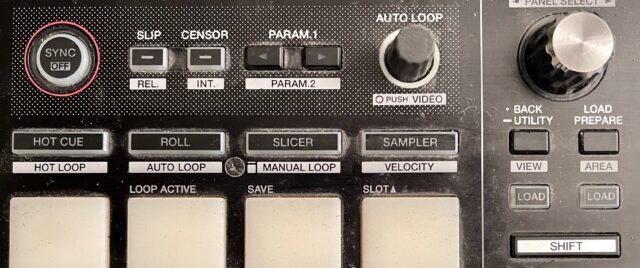
“Pads”
Much like the controls, I wonder why Pioneer DJ changed the pads to the hard, clicky buttons. For the most part, it is perfectly functional and ultimately a personal preference, but we’ve gone over a decade with rubber pads being the norm, and I much prefer the feel. On top of that, I experienced more misfires and double-triggers on the buttons than I usually do with pads.
Software Effects
While I like how Pioneer DJ designed the software effect controls, Serato’s software effects have always been mediocre to me at best. Of course, it doesn’t help that there hasn’t been a significant update to their effects or the design in years.
No bundled cables and records
With the DJM-S5, your only accessory is a single USB-C to USB-A cable. Following Apple’s footsteps, you don’t even get a power adaptor. Bundling DVS control records with Pioneer DJ mixers also seems like a thing of the past.
Considering the mixer requires a pair of USB-C cables to work (one to connect to the laptop and one to connect to the power adapter), even two cables would have been preferred.
Auto-fader effects
On my Rane Seventy-Two, these effects feel like wasted controls that could be used on something better. I feel the exact same way about them on the DJM-S5. I prefer using my fader technique to scratch and it feels like we could see a better use for these secondary buttons.
How does it compare to the Numark Scratch?
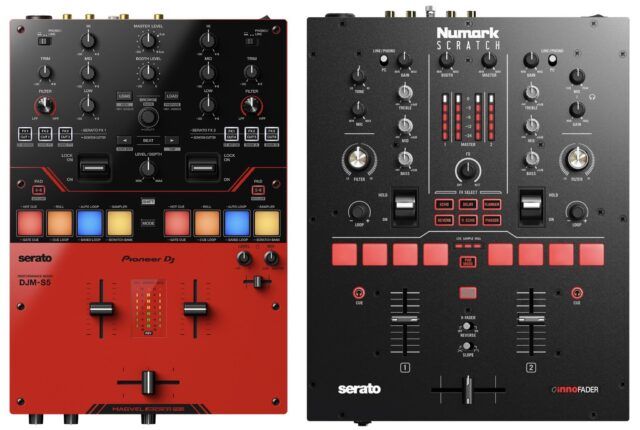
Many may feel tempted to compare the DJM-S5 to the Numark Scratch but there really is no comparison. While the Numark Scratch remains the single most affordable Serato mixer from a feature-to-price perspective, the DJM-S5 is easily a step up in features and functionality.
The question is: is it $300 more of a mixer? For the most part, I think it is. The Magvel Pro fader is better than the standard Mini Innofader on the Scratch – especially considering the Scratch uses Serato for audio routing for digital, which is far inferior for scratching. Also, while not my favourite, the improved controls are still vastly superior to the ultra-limited Numark Scratch.
Consider that if you wanted similar functionality to the DJM-S5 on the Numark Scratch, you would need to add an Innofader Pro2 ($150) and something like a DDJ-XP2 ($319). Granted, using an XP2 is vastly superior to the onboard controls on the DJM-S5.
Of course, if you don’t need all the extra bells and whistles, it’s still hard to beat the bang-for-buck of the Numark Scratch.
Final Thoughts
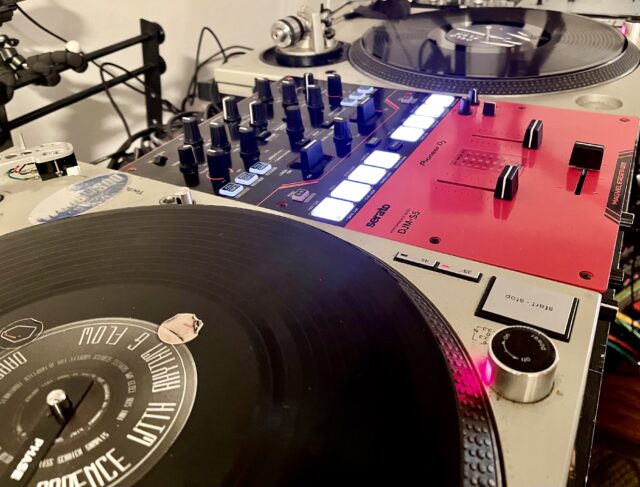
I’ll be honest; I didn’t enjoy playing on the DJM-S5 much. The convoluted Pad Mode control scheme doesn’t work for my play style. For most of my time DJing on the DJM-S5, I felt like I was fighting against my muscle memory that had developed over a decade of playing on controllers and high-end Serato mixers. I have an easier time switching between Rane mixers and the DJM-S11 and S7 than playing on the DJM-S5.
I feel the same way about the DJM-S9 and constantly wonder why Pioneer DJ changed from a proven and effective control scheme – one that they implement on virtually every other piece of equipment – to something so different.
While I have gotten more used to the controls after a month, I still don’t enjoy using the mixer outside of scratching vinyl.
The best part about the DJM-S5 was the Magvel Pro crossfader. As someone who scratches at a fairly high level, the fader might be worth the price of admission alone.
Features aren’t always everything
Objectively, the quality is fine for what you pay. One of the highlights is getting one of the best scratch faders on the market. The effect controls are also great and give you that dynamic and intuitive feel of their higher-end mixers. The sound quality is decent enough and better than the old DJM-S9 (even if it’s a step below their higher-end modern mixers). You get independent – and many more – pad modes and the intuitive Pioneer DJ effects control. The battery-ready USB-C power system is also a fantastic bonus.
But at the end of the day, I never gelled with the control scheme.
If you’re used to playing on something like a Rane Seventy or DJM-S11, you may also struggle with the DJM-S5. Adding something like a DDJ-XP2 would drastically improve the DJM-S5 experience for me, but if I need to add $300 to the price tag, I might as well save up for a DJM-S7.
DJay Pro AI changed my mind
I originally was ready to say, “just skip this and save up a few hundred more and get the DJM-S7.”
Then DJay Pro AI DVS support dropped and just – wow.
Being able to take the DJM-S5 and my Reloop SPiN and play off my phone using just batteries was incredible. Sure, I still struggled mightily with the controls and playing off a belt-driven portable deck is challenging at best, but the sheer fun of having a mobile setup with a fader like the Magvel Pro and a full-size scratch mixer setup with my phone was a ton of fun.
I only wish I still had the Denon LC6000s to use with the DJM-S5, as I feel that would be the perfect portable setup to use (albeit with a laptop).
So, who is this for?
- Scratch/battle DJs – the Magvel Pro is arguably the best scratch fader on the market. For DJs that scratch more than they mix, having a sub-$1000 mixer with this fader is amazing. The DJM-S5 also offers enough in the ways of Serato and performance bells and whistles to take mixing beyond the basics.
- DJs looking for portable devices – the DJM-S5 shines as a portable device – even if it’s a little large and the options for portable players is pretty limited.
- DJs updating from a mixer like a Rane 57 or 62, or an analog mixer from a few generations back.
- DJs looking for a backup mixer – there’s just enough features on the DJM-S5 to make it work for standard gigs. While I wouldn’t make it my daily driver, it’s enough to get through most of my gigs.
- Beginner scratch DJs – Magvel Pro fader for under $1000 – ’nuff said.
That said, anyone experienced with a high-end mixer like the S7/S9/S11 or the Rane mixers might be disappointed with the controls. Even transitioning from a standard controller like the DDJ-1000 or SX will require a learning curve.
The DJM-S5 is ultimately an interesting mixer. It ticks many boxes for a sub-$1000 DVS mixer, but I feel it has some missteps in the design. It’s not entirely intuitive or robust enough to satisfy some of the power users out there (like me) – but it’s also not cheap enough to be considered an actual entry-level piece of gear. Instead, it fills the space once occupied by the Traktor Z2 and the Mixars Duo: A solid but somewhat limited mid-level offering.
You can find Pioneer DJ’s DJM-S5 in the DJ Techtools shop for $839.





